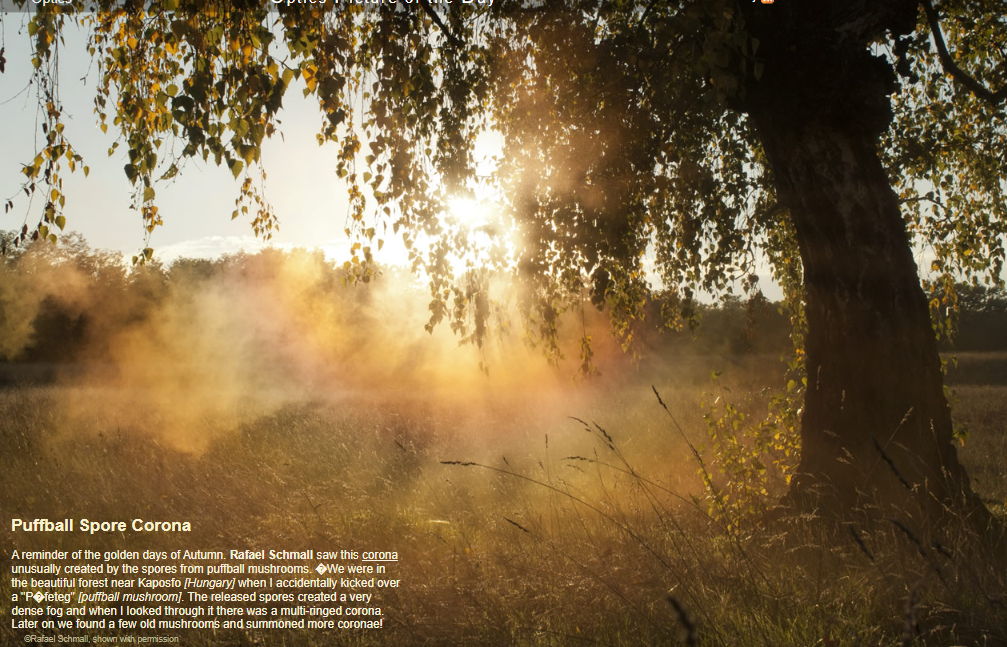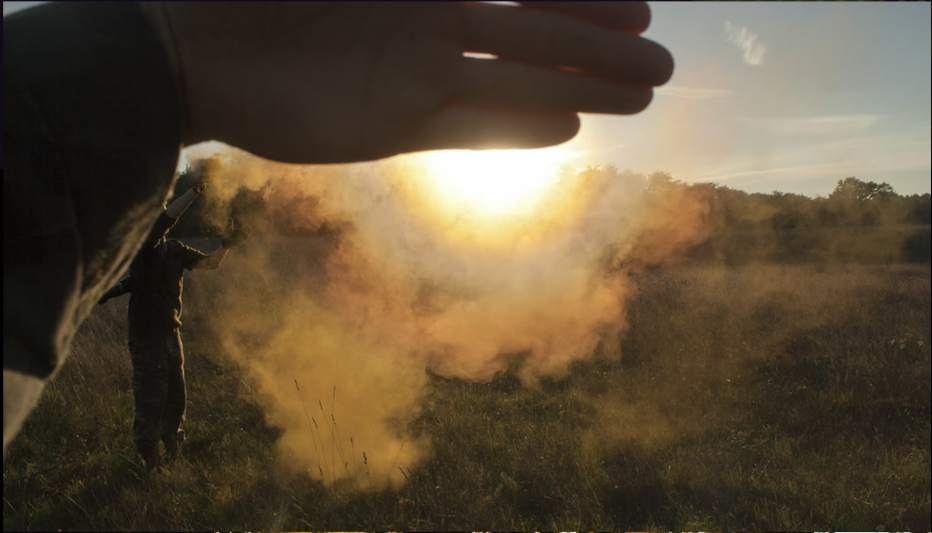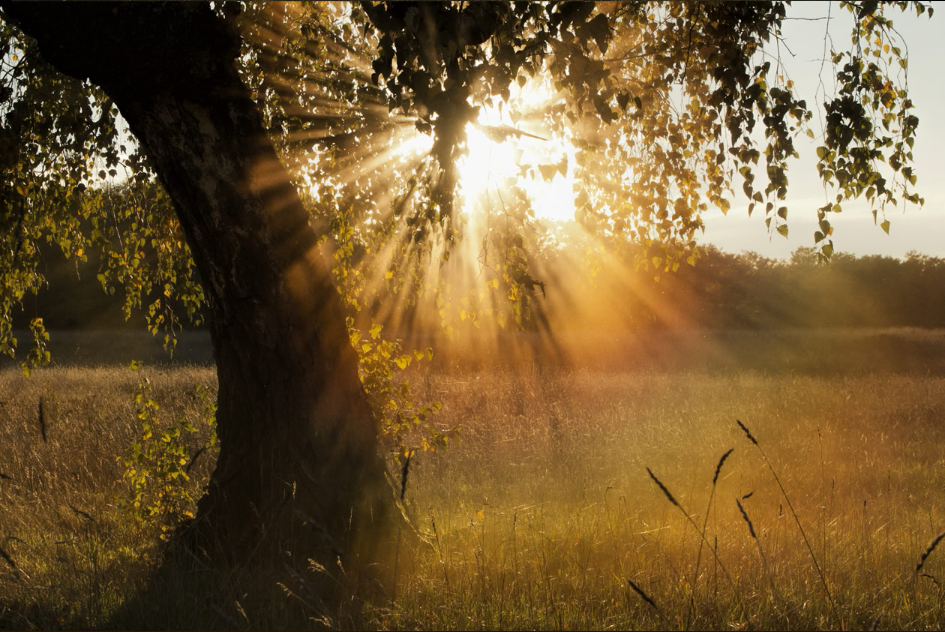Puffball mushroom spore corona - OPOD
Puffball Mushroom Spore Corona: A Mesmerizing Autumn Phenomenon
As the golden days of autumn unfold, nature unveils its enchanting wonders. One such captivating spectacle is the puffball mushroom spore corona. These ephemeral coronae are formed when the spores of puffball mushrooms are released into the air, creating a dense fog-like cloud. When observed through this mist, a mesmerizing multi-ringed corona emerges, casting a spellbinding display of light and color. This extraordinary phenomenon was captured by Rafael Schmall in the beautiful forests near Kaposfo, Hungary.
The Unique Nature of Puffball Mushroom Spore Clouds
What sets the cloud formed by disturbed puffball mushrooms apart is the uniform size of the tiny spores. Under the lens of a scanning electron microscope, the spores appear as prickly spheres with a diameter of only 3.7 microns (0.004mm). This monosized characteristic makes them ideal for producing coronae. While cloud and mist droplets, as well as pollens, are known sources of coronae, the occurrence of coronae from mushroom spores is a remarkable discovery.
The Science Behind the Puffball Mushroom Spore Corona
The puffball mushroom spore corona is a diffraction pattern characterized by a central aureole surrounded by several colored rings. When incident light encounters the spores or other small particles, it scatters in all directions as outgoing spherical waves. The spreading waves overlap either constructively or destructively. In the far field, where the overlapped waves are in phase, light is observed, while completely out-of-phase directions yield darkness.
The angular size of the resulting corona depends on the diameter of the source particles. Interestingly, smaller particles generate larger coronae, making monosized particles highly desirable for producing sharp coronae with multiple rings. Analysis of Rafael Schmall's images indicates a spore diameter of approximately 4.2 microns, which falls within the range of puffball mushroom spore sizes.
To visualize the scattering process, consider a schematic where only two surface points are involved. When the entire surface participates, a circular pattern, such as the one observed in puffball mushroom spore coronae, emerges.
Delving Deeper into the Puffball Mushroom Spore Corona Phenomenon
While the captivating images captured by Rafael Schmall provide a glimpse into the mesmerizing world of puffball mushroom spore coronae, there is still much to explore and understand about this natural spectacle. Further research and analysis can shed light on various aspects, including:
- Investigating the specific conditions under which puffball mushroom spore coronae form, such as humidity levels, temperature, and atmospheric stability.
- Examining the variations in puffball mushroom spore sizes and their influence on the appearance and complexity of the coronae.
- Exploring the potential occurrence of puffball mushroom spore coronae in different geographical locations and during different seasons.
- Studying the optical properties of other monosized particles to determine if similar coronae can be produced.
- Collaborating with experts in atmospheric optics to gain insights into the unique characteristics and behaviors of puffball mushroom spore coronae.
The Beauty and Transience of Nature's Masterpieces
The puffball mushroom spore corona is a testament to the intricate beauty and transient nature of natural phenomena. It serves as a reminder of the countless wonders that surround us, waiting to be discovered and appreciated. As we continue to delve into the mysteries of atmospheric optics, let us marvel at the captivating displays nature unveils, capturing our imagination and inviting us to explore the realms beyond our everyday perception.

Puffball Spore Corona
A reminder of the golden days of Autumn. Rafael Schmall saw this corona unusually created by the spores from puffball mushrooms. �We were in the beautiful forest near Kaposfo .Hungary. when I accidentally kicked over a "P�feteg" .puffball mushroom.. The released spores created a very dense fog and when I looked through it there was a multi-ringed corona. Later on we found a few old mushrooms and summoned more coronae! ©Rafael Schmall, shown with permission

The cloud from the disturbed puffball mushroom is special in that the tiny spores are all of the same size. At right the scanning electron micrograph by Alex Hyde (Alex Hyde Photography) shows spores from Calvatia gigantea. The prickly spheres are a mere 3.7 micron ( 0.004mm ) diameter.
Monosized particles are ideal for producing coronae. Apart from cloud and mist droplets, pollens are well known sources. These coronae from mushroom spores are possibly a first.

The corona of a central aureole surrounded by several coloured rings is a diffraction pattern. The spores, or whatever small particles, scatter incident light in all directions as outgoing spherical waves. The spreading waves overlap constructively or destructively. In the far field, directions where the overlapped waves are in phase there is light, completely out of phase directions yield darkness.
The angular size of the resulting corona depends on the diameter of the source particles. Smaller particles give larger coronae – Hence the desirability of monosized particles for the sharpest coronae with many rings.
Analysis of Rafael Schmall’s images gives a spore diameter of 4.2 micron, very much in the range of those from puffball mushroom varieties.
This schematic shows scattering from only two surface points. The circular pattern results when the whole surface participates.


Note: this article has been automatically converted from the old site and may not appear as intended. You can find the original article here.
Reference Atmospheric Optics
If you use any of the definitions, information, or data presented on Atmospheric Optics, please copy the link or reference below to properly credit us as the reference source. Thank you!
-
<a href="https://atoptics.co.uk/blog/puffball-mushroom-spore-corona-opod/">Puffball mushroom spore corona - OPOD</a>
-
"Puffball mushroom spore corona - OPOD". Atmospheric Optics. Accessed on November 26, 2024. https://atoptics.co.uk/blog/puffball-mushroom-spore-corona-opod/.
-
"Puffball mushroom spore corona - OPOD". Atmospheric Optics, https://atoptics.co.uk/blog/puffball-mushroom-spore-corona-opod/. Accessed 26 November, 2024
-
Puffball mushroom spore corona - OPOD. Atmospheric Optics. Retrieved from https://atoptics.co.uk/blog/puffball-mushroom-spore-corona-opod/.